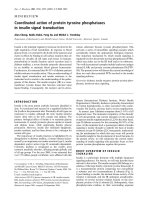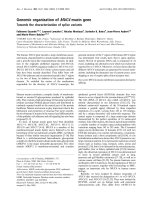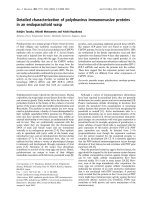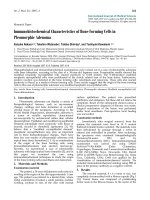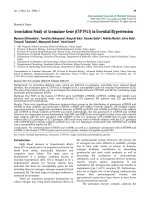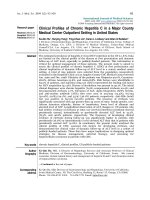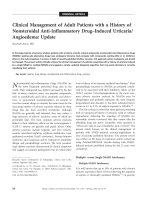Báo cáo y học: "Clinical audit of core podiatry treatment in the NH" ppsx
Bạn đang xem bản rút gọn của tài liệu. Xem và tải ngay bản đầy đủ của tài liệu tại đây (365.74 KB, 6 trang )
BioMed Central
Page 1 of 6
(page number not for citation purposes)
Journal of Foot and Ankle Research
Open Access
Research
Clinical audit of core podiatry treatment in the NHS
Lisa Farndon*
1
, Andrew Barnes
2
, Keith Littlewood
3
, Justine Harle
4
,
Craig Beecroft
5
, Jaclyn Burnside
6
, Tracey Wheeler
7
, Selwyn Morris
8
and
Stephen J Walters
9
Address:
1
Podiatry Services, Sheffield PCT, Jordanthorpe Health Centre, Sheffield, S8 8DJ, UK,
2
Podiatry Department, Barnsley PCT NHS Trust,
New Street Clinic, Upper New Street, Barnsley, S70 1LP, UK,
3
Podiatry Department, North Lincolnshire & Goole Hospital NHS Foundation Trust,
Diana Princess of Wales Hospital, Scartho Road, Grimsby, DN33 2BA, UK,
4
Department of Foothealth, Bassetlaw PCT, Retford Hospital, North
Road, Retford, Notts, DN22 7XF, UK,
5
Podiatry Department, Ashfield Health Village, Kirkby-in-Ashfield, Notts, NG17 7AE, UK,
6
Podiatry
Department, Nottinghamshire County Teaching PCT, Park House Health and Social Care Centre, 61 Burton Road, Carlton, Nottingham, NG4
3DQ, UK,
7
Podiatry Services, Doncaster PCT, East Laith Gate House, East Laith Gate, Doncaster, DN1 1JE, UK,
8
Lincolnshire PCT, Podiatry
Department Marisco Medical, Stanley Avenue, Mablethorpe, LN12 1DP, UK and
9
ScHARR, University of Sheffield, Regent Court, 30 Regent St,
Sheffield, S1 4DA, UK
Email: Lisa Farndon* - ; Andrew Barnes - ;
Keith Littlewood - ; Justine Harle - ;
Craig Beecroft - ; Jaclyn Burnside - ;
Tracey Wheeler - ; Selwyn Morris - ; Stephen J Walters -
* Corresponding author
Abstract
Background: Core podiatry involves treatment of the nails, corns and callus and also giving footwear and foot health
advice. Though it is an integral part of current podiatric practice little evidence is available to support its efficacy in terms
of research and audit data. This information is important in order to support the current NHS commissioning process
where services are expected to provide data on standards including outcomes. This study aimed to increase the evidence
base for this area of practice by conducting a multi-centre audit in 8 NHS podiatry departments over a 1-year period.
Methods: The outcome measure used in this audit was the Podiatry Health Questionnaire which is a self completed
short measure of foot health including a pain visual analogue scale and a section for the podiatrist to rate an individual's
foot health based on their podiatric problems. The patient questionnaire was completed by individuals prior to receiving
podiatry care and then 2 weeks after treatment to assess the effect of core podiatry in terms of pain and foot health.
Results: 1047 patients completed both questionnaires, with an age range from 26–95 years and a mean age of 72.9 years.
The podiatrists clinical rating at baseline showed 75% of patients had either slight or moderate podiatric problems. The
differences in questionnaire and visual analogue scores before and after treatment were determined according to three
categories – better, same, worse and 75% of patients' scores either remained the same or improved after core podiatry
treatment. A student t-test showed a statistical significant difference in pre and post treatment scores where P < 0.001,
though the confidence interval indicated that the improvement was relatively small.
Conclusion: Core podiatry has been shown to sustain or improve foot health and pain in 75% of the patients taking
part in the audit. Simple outcome measures including pain scales should be used routinely in podiatric practice to assess
the affect of different aspects of treatments and improve the evidence base for podiatry.
Published: 13 March 2009
Journal of Foot and Ankle Research 2009, 2:7 doi:10.1186/1757-1146-2-7
Received: 9 September 2008
Accepted: 13 March 2009
This article is available from: />© 2009 Farndon et al; licensee BioMed Central Ltd.
This is an Open Access article distributed under the terms of the Creative Commons Attribution License ( />),
which permits unrestricted use, distribution, and reproduction in any medium, provided the original work is properly cited.
Journal of Foot and Ankle Research 2009, 2:7 />Page 2 of 6
(page number not for citation purposes)
Background
A large number of the general population experience foot
problems which is highlighted by a review of foot survey
data from the UK and overseas (Australia, America and
Europe) [1]. Various methods have been used to survey
the incidence of foot problems, including an examination
by a professional, face to face or telephone interviews and
postal questionnaires. A summary of combined surveys
found that between 20–78% of people suffer from corns,
callus and bunions, between 20–49% have lesser toe
deformities and 28–56% have toenail problems [1]. The
incidence and types of foot problems are variable when
reported via surveys due to the types of populations stud-
ied and whether foot problems are self reported or
assessed by a health professional. In the past the vast
majority of surveys have concentrated on foot problems
in older people, whether in residential care, on a hospital
ward or living in the community. Understandably, when
a professional diagnoses and reports foot problems the
incidence is higher than when compared with those that
are self reported. The high incidence of foot pathologies in
the population is reflected in the number of people access-
ing podiatry care; the most recent figures available show 2
million people are treated annually by the NHS, 769,000
of these are new episodes of care of which 56% are for
older people [2].
Podiatry practice includes the treatment of foot patholo-
gies associated with the nails and soft tissues, such as
corns and callus; which is regarded as core podiatry treat-
ment and is required for these types of conditions [3].
Currently, little evidence exists to support the efficacy of
core podiatry treatments though anecdotally podiatrists
believe them to be beneficial. Some studies have investi-
gated the pain relieving properties of scalpel debridement.
One multi-centre NHS based project included 79 patients
and found that they reported a reduction in pain after
treatment when pre and post operative pain scores using
a Visual Analogue Scale (VAS) were used and this was sta-
tistically significant, though the benefit was not sustained
[4]. Reduction of callus with a scalpel was also found to
reduce pain again using a pain VAS directly after treatment
and seven days later, in conjunction with improving func-
tional ability in a small group of older adults [5]. A small
qualitative study using semi-structured interviews with
older people, found that core podiatry treatment gave
both a physical benefit to those who receive it as well as
some degree of emotional reassurance as having contin-
ued care was felt to sustain individuals' foot health [6].
Current research priorities identified for podiatric practice
also include treatment effectiveness, as a major issue requir-
ing further investigation [7], and one way to explore this
is to use an outcome measure.
In the last decade, specific podiatric outcome measures
have been developed to measure the efficacy of different
types of interventions and treatments.
The Foot Function Index (FFI) was designed and validated
in a study by Budiman-Mak and colleagues [8] to assess in
terms of pain, disability and activity restriction; the
impact that foot pathologies have on function. Bennet
and Patterson [9] describe the development of The Foot
Health Status Questionnaire (FHSQ), which is designed
to measure foot health related quality of life. Other meas-
ures have been developed which are more patient centred.
Garrow et al [10] developed and validated a tool to meas-
ure foot pain and disability sensitive to individuals with a
range of different problems affecting mobility. Waxman
and colleagues [11] later used this in a randomised con-
trolled trial measuring the effect of a self-care foot pro-
gramme for older people. The Bristol Foot Score [12] was
formulated after consultations with groups of patients
and individuals. The authors suggest that patient as well as
practitioner views should be considered when assessing
the usefulness and efficacy of different podiatric interven-
tions.
The Podiatry Health Questionnaire (PHQ) was developed
to be self completed by patients and was evaluated by
Macran et al [13] in 2038 individuals across four UK podi-
atry departments. It consists of 6 foot related questions
with a choice of 3 responses for each around the dimen-
sions of walking, foot hygiene, nail care, foot pain, worry
about feet and impact on quality of life. It was used in
combination with a visual analogue pain scale (VAS) and
a Podiatry Objective Clinical Score (POCS) which is clin-
ical measure of current foot problems as determined by a
podiatrist and rated from 1 (no problems) to 5 (gross
problems) (Additional file 1). The results were compared
with a generic measure of health status (EQ-5D) to assess
podiatry outcomes. The PHQ was found to be a useful
measure of foot health and showed a good correlation
between self-reported morbidity in this tool and the EQ-
5D.
This paper describes a multi-centre audit of podiatry
patients receiving core podiatry care using the PHQ as
described by Macran et al [13] to investigate outcomes.
The 6 items on PHQ were combined to generate a single
score ranging from 6 to 18, with a higher score indicating
more severe problems. The 11 point VAS scale ranged
from 0 (no pain) to 10 (worst pain).
As changes are being made in the way NHS services are
commissioned and delivered [14] it is envisaged that the
results of this audit will be able to contribute towards
Journal of Foot and Ankle Research 2009, 2:7 />Page 3 of 6
(page number not for citation purposes)
offering evidence for the effectiveness of core podiatric
practice.
Method
As this was a simple audit, ethical committee approval
was not required, but all participating patients were asked
to give their verbal consent after a full explanation of the
audit process was outlined, prior to the questionnaires
being completed. Eight podiatry departments in the Trent
and South Yorkshire region took part in the audit ranging
from a small department consisting of 4 staff and serving
a mainly rural population to one with over 50 staff with a
mixed rural and urban population. A random sample of
adult patients who attended core community podiatry
clinics in the 8 regions were asked to complete the PHQ
prior to their treatment. The podiatrist carrying out the
treatment then completed the podiatry objective clinical
score, which categorises a patient into one of five sections
according to the severity of their foot problems (5 repre-
senting gross problems). All podiatrists taking part were
given brief training in how to complete the questionnaire,
but inter-rater reliability tests were not conducted, as the
study was trying to replicate current practice. After each
treatment had concluded, a follow up PHQ was given out
to each patient and they were asked to complete and
return it 2 weeks after their initial treatment. This was
decided as the most appropriate time frame for a treat-
ment outcome to be measured, as it was thought that ask-
ing the patient to complete the questionnaire directly after
treatment might be introducing an element of bias, as the
patient may feel obliged to give a favourable opinion. The
date when the second questionnaire should be completed
was written on the form to remind the patient when it
should be filled in.
Inclusion criteria for the audit were; patients who were
attending core podiatry treatment, who were able to give
verbal consent and were over 18 years old. Data was col-
lected over a 12-month period in each of the 8 podiatry
departments. Departments then entered their data onto
an Excel spreadsheet and results were combined and
migrated into the Statistical Package for Social Scientists
(SPSS) for statistical analysis. The PHQ-score and VAS
outcomes were regarded as continuous outcomes. The
change in PHQ-score and VAS from baseline to 2 weeks
was compared using a paired t-test. A 95% confidence
interval (CI) for the mean change in scores over time was
also calculated. A p-value of < 0.05 was regarded as statis-
tically significant. The change in VAS and PHQ score from
baseline to 2 weeks was also categorised into three levels;
same, better or worse, with a same category corresponding a
change score of 0.
Results
Baseline data (see Table 1 &2)
One thousand and forty-seven patients receiving core
treatment completed and returned both questionnaires.
The response rate was not calculated as not all services
kept a tally of the number of questionnaires originally
given out.
Tables 1 and 2 show the baseline clinical and demo-
graphic characteristics of the patients. The mean age was
72.9 years (range 26–95 years) with 63.5% females and
36.5% males. Ninety per cent (946) were current patients;
the remaining 10% (100) were new patients. Thirty-two
per cent (325) of patients had diabetes. The mean pain
VAS was 4.8 with 28 missing scores. The questionnaire –
How are your feet today? could elicit possible scores
between 6 (low need) up to 18 (high need). The mean
score for this at baseline was 11.8.
The Podiatry Objective Clinical Score (POCS) indicated
that 75% of patients were suffering from slight or moder-
ate podiatric problems, however 5.5% were classed as
having no problems, so would probably be attending for
nail care or foot care advice only. Table 2 indicates the
baseline figures for the 8 centres submitting data.
Table 3 shows the VAS and PHQ scores before and after
treatment (59 missing VAS scores). For both outcomes
there was a statistically significant improvement in scores
after treatment (p < 0.001). However, the 95% confidence
intervals for the mean change in scores are relatively
small; a change of 0.7 for the VAS scores and 0.6 for the
PHQ scores.
The changes in PHQ questionnaire and VAS scores before
and after treatment were also reclassified into three cate-
gories – better, same, worse (see Figure 1). Seventy-five per
cent of patients reported that their foot health and pain
levels had improved or remained the same after receiving
Table 1: Baseline demographics of audit patients (n = 1047)
n mean standard deviation minimum maximum
Age 1047 72.9 11.1 26 95
VAS 1019 4.8 2.8 0 10
Questionnaire score 1047 11.8 6 6 18
Podiatry clinical score 1042 2.8 1 1 5
*For the VAS, questionnaire and Podiatry Clinical Scores; a higher number represents more severe problems
Journal of Foot and Ankle Research 2009, 2:7 />Page 4 of 6
(page number not for citation purposes)
core podiatry treatment, though the remaining 25% stated
that they were worse.
Discussion
Core podiatry treatment was found to give a statistically
significant improvement in terms of pain and foot health,
though the change was relatively small. Twenty-five per
cent of patients reported higher questionnaire scores and
pain scores after receiving treatment suggesting that their
foot health was deteriorating. This may have occurred for
a number of reasons. The average age of this group was 72
years, and older people may possibly be suffering from
complex medical problems that could affect their pain
and mobility [15]. Macran et al's study which first used
the PHQ found that from a sample of 2073 patients with
the same mean age of 72 years, 82% were being treated for
one of the following conditions – rheumatism/arthritis,
respiratory problems, heart/circulatory disorders, diabetes
and cancer.
The first two statements of the PHQ are about walking
and hygiene and therefore a general measure of foot
health which may not be altered after receiving podiatry
treatment. Some patients may have been worried that they
could be discharged if they reported greatly improved foot
health as most NHS podiatry services now have access and
discharge criteria based on clinical need. Some podiatrists
taking part in the audit reported that some patients did
not really understand how to fill in the pain VAS, which
again may account for some higher than expected scores
and the missing data. If this audit was repeated, help
should be offered and further explanation if necessary to
patients when they are completing the VAS to ensure that
it is completed in the correct manner.
The time scale to complete the post treatment question-
naire for core podiatry was decided at 2 weeks. If the ques-
tionnaire had been completed straight after a core
treatment, this again may have given improved outcome
scores as the greatest benefit may be felt at this time. How-
ever, the optimum time to achieve the maximum advan-
tage from a podiatry treatment in terms of foot health and
pain has never really been determined, though a two week
follow up has been used before in a similar audit [12]. The
majority of patients (over 70%) reported an improvement
or no change in their foot health and pain scores after
treatment. In a group receiving core podiatry care, this
might be expected, as sustaining foot health is an accepta-
ble outcome in people who may have mobility problems
and pain, some of which may be associated with systemic
Table 2: Baseline demographics of audit patients (cont)
n%
Location Podiatry Service 1 109 10.4
Podiatry Service 2 76 7.3
Podiatry Service 3 101 9.6
Podiatry Service 4 25 2.4
Podiatry Service 5 49 4.7
Podiatry Service 6 126 12
Podiatry Service 7 14 1.3
Podiatry Service 8 547 52.2
Gender Male 382 36.5
Female 664 63.5
Patient Status Current Patients 946 90.4
New Patients 100 9.6
Diabetes 325 31.7
Podiatry objective clinical score (POCS) No problems 57 5.5
Slight problems 357 34.3
Moderate problems 427 41
Severe problems 181 17.4
Gross problems 20 1.9
Table 3: Change in questionnaire and VAS score before and after treatment
Before After Mean 95% CI
N Mean SD Mean SD Change Lower Upper P-value
Q Score 1047 11.8 2.6 11.2 2.7 0.5 0.4 0.7 < 0.0001
VAS 988 4.8 2.8 4.1 2.7 0.7 0.6 0.9 < 0.0001
*For the VAS, Questionnaire Scores; a higher number represents more severe problems.
A positive mean P-value from paired t-test change implies an improvement or reduction in severity of problems over time.
Journal of Foot and Ankle Research 2009, 2:7 />Page 5 of 6
(page number not for citation purposes)
diseases. This concurs with the results of another study
which used the Bristol Foot Score as an outcome measure
and found no statistical improvement in foot health 2
weeks after core podiatry treatment in a group with a sim-
ilar mean age [12]. However, withdrawing podiatry care
in older people classed as 'low risk' has been found to lead
to the development of more serious foot problems in
some and this is associated with a reduction in independ-
ence and ageing [15]. This group of people are also more
likely to have mobility problems, which can result in dif-
ficulties providing self foot care [16].
The outcome measure used consisted of some general
questions to give an indication of self-care ability, which
is useful when assessing need for core podiatry care. The
self-assessment questionnaire did not really take into
account that some patients may have been suffering from
co-morbidities which may have been affecting their pain
and foot health and that might not be improved by podi-
atry care. Campbell [17] recommends that a universal
assessment tool is required in podiatric practice to meas-
ure foot health in older low risk people. She suggests this
should include assessments of foot health, self-care, cal-
lused feet, neurological and vascular problems. Such a
tool could be developed with different domains associ-
ated with the different specialities in current podiatry and
be applicable to all ages.
Conclusion
In this large multi-centre audit core podiatry treatment
was shown to improve outcomes in terms of foot health
and pain which was statistically significant. The improve-
ments however were relatively small which highlights that
the podiatry profession needs to determine what a clini-
cally significant improvement is before further work in
this area can be carried out to assess the effectiveness of
core podiatry care or other aspects of podiatric practice.
It is important for simple outcome measures to be incor-
porated into day-to-day clinical care to ensure that ongo-
ing treatments are evaluated and evidence is available to
support such interventions. The VAS pain scale was a rela-
tively simple tool to use and could easily be incorporated
into current patient records including paper and elec-
tronic systems, though some older people required some
help with its completion. Those with visual problems
would be disadvantaged, but a verbal description made to
the clinician could be substituted if required.
As the sample sizes differed dramatically in the depart-
ments taking part in this audit, it is difficult to adequately
benchmark clinical outcomes across the region. But the
overall sample size, though not representing the total
population of those receiving core podiatry care, is still a
large number of patients, compared with most previous
reports using outcome measures.
This audit has given some valuable information regarding
the effect of core podiatry treatment and has highlighted
the need for outcome measures to be incorporated into
daily podiatric practice to increase its evidence base.
Competing interests
The authors declare that they have no competing interests.
Authors' contributions
LF conceived of the study and drafted the manuscript with
the participation of AB, KL, JH, CB, JB, TW, SM and SW.
Changes in questionnaire and VAS scores categorised as worse, same or betterFigure 1
Changes in questionnaire and VAS scores categorised as worse, same or better.
Publish with Bio Med Central and every
scientist can read your work free of charge
"BioMed Central will be the most significant development for
disseminating the results of biomedical research in our lifetime."
Sir Paul Nurse, Cancer Research UK
Your research papers will be:
available free of charge to the entire biomedical community
peer reviewed and published immediately upon acceptance
cited in PubMed and archived on PubMed Central
yours — you keep the copyright
Submit your manuscript here:
/>BioMedcentral
Journal of Foot and Ankle Research 2009, 2:7 />Page 6 of 6
(page number not for citation purposes)
AB collated the results and prepared them for statistical
analysis. SW performed the statistical analysis. All authors
read and approved the final manuscript.
Additional material
Acknowledgements
The authors would like to thank all the podiatry service managers who gave
their staff time to carry out this audit, the clinicians that completed the out-
come measure forms and the patients who took part. We would also like
to thank the Yorkshire Regional Podiatry Network Managers Group and
the Health Outcomes Group from the Centre for Health Economics at the
University of York who designed this outcome measure, especially Robin
Hull for his help and advice.
References
1. Farndon LJ, Vernon DW, Parry A: What is the evidence for the
continuation of core podiatry services in the NHS: A review
of foot surveys. British Journal of Podiatry 2006, 9(3):89-94.
2. Health and Social Care Information Centre: NHS Chiropody Serv-
ices Summary Information for 2004–05 England. Health and
Social Care Information Centre: London; 2005:1-4.
3. Farndon LJ, Vernon DW, Potter J, Parry A: The Professional Role
of the Podiatrists in the new millennium: An analysis of cur-
rent practice: Paper 1. The British Journal of Podiatry 2002,
5(3):68-72.
4. Redmond A, Allen N, Vernon W: Effect of scalpel debridement
on the pain associated with plantar hyperkeratosis. Journal of
the American Podiatric Medical Association 1999, 89(10):515-519.
5. Balanowski KR, Flynn LM: Effect of painful keratoses debride-
ment on foot pain, balance and function in older adults. Gait
and Posture 2005, 22:302-307.
6. Farndon LJ: The function and purpose of core podiatry: An in-
depth analysis of practice. In Faculty of Health and Wellbeing Shef-
field Hallam University; 2006.
7. Vernon W: A Delphi exercise to determine current research
priorities in podiatry. British Journal of Podiatry 2005, 8(1):11-15.
8. Budiman-Mak E, Conrad KJ, Roach KE: The foot function index: A
measure of foot pain and disability. Journal of Clinical Epidemiology
1991, 44(6):561-570.
9. Bennett PJ, Patterson C: The Foot Health Status Questionnaire
(FHSQ): a new instrument for measuring outcomes of foot
care. Australasian Journal of Podiatric Medicine 1998, 32(3):87-92.
10. Garrow AP, Papageorgiou AC, Silman AJ, Thomas E, Jayson MIV, Mac-
farlane GJ: Development and validation of a pain question-
naire to assess disabling foot pain. Pain 2000, 85:107-113.
11. Waxman R, Woodburn H, Powell M, Woodburn J, Blackburn S, Hel-
liwell P: FOOTSTEP: a randomized controlled trial investi-
gating the clinical and cost effectiveness of patient self-
management program for basic foot care in the elderly. Jour-
nal of Clinical Epidemiology 2003,
56(11):1092-1099.
12. Barnett S, Campbell R, Harvey I: The Bristol Foot Score: Devel-
oping a patient-based foot-health measure. J Am Podiatr Med
Assoc 2005, 95(3):264-272.
13. Macran S, Kind P, Collingwood J, Hull R, McDonald I, Parkinson L:
Evaluating podiatry services: testing a treatment specific
measure of health status. Quality Of Life Research: An International
Journal Of Quality Of Life Aspects Of Treatment, Care And Rehabilitation
2003, 12(2):177-188.
14. Department of Health: Commissioning a patient-led NHS.
Department of Health: London; 2005.
15. Lundgren-Lindquist B, Jette AM: Mobility disability among elderly
men and women in Sweden. International Disability Studies 1990,
12(1):1-5.
16. Campbell J: Modelling deterioration of foot health in older
people following discharge from NHS podiatry services. The
Foot 2007, 17:76-83.
17. Campbell J: Characteristics of the foot health of 'low risk' older
people: A principal components analysis of foot health meas-
ures. The Foot 2006, 16(1):44-50.
Additional file 1
The patient health questionnaire. Patient questionnaire.
Click here for file
[ />1146-2-7-S1.doc]

